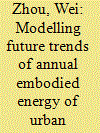| Srl | Item |
| 1 |
ID:
185688


|
|
|
|
|
| Summary/Abstract |
China is the largest driver of growth in the global building sector. The longstanding construction boom across China has generated a massive flow of materials with significant associated embodied energy consumption and carbon emissions. Despite the serious implications for global emissions, there exist a very limited number of macro-level studies on embodied energy of Chinese buildings, with even fewer exploring future scenarios. There is therefore little in the way of an evidence base to offer policy makers. We develop a probabilistic model to forecast the possible trajectories of embodied energy of residential buildings over the medium to long term in the Chinese urban context. Our results provide clear evidence to substantiate the importance of embodied energy of new construction, which we find to be over 0.3 times the operational energy of existing stock between 2010 and 2018. If current trajectories are followed, embodied energy is likely to peak around 2027, with a 95% credible interval ranging from 87 to 283 Mtce (61 to 198 Mtoe) and a mean of 170 Mtce (119 Mtoe). We show that building lifetime has a substantial impact on future annual and cumulative embodied energy. Our findings reinforce the need to take a whole-life perspective to formulate policies addressing building energy as part of China's efforts to meet the announced overarching target of achieving carbon neutrality by 2060.
|
|
|
|
|
|
|
|
|
|
|
|
|
|
|
|
| 2 |
ID:
123733


|
|
|
|
|
| Publication |
2013.
|
| Summary/Abstract |
High crude oil prices and the eventual decline of conventional oil production raise the issue of alternative fuels such as non-conventional oil. The paper describes a simple probabilistic model of the costs of synthetic crude oil produced from Canadian oil sands. Synthetic crude oil is obtained by upgrading bitumen that is first produced through mining or in-situ recovery techniques. This forward-looking analysis quantifies the effects of learning and production constraints on the costs of supplying synthetic crude oil. The sensitivity analysis shows that before 2035, the most influential parameters are the learning parameter in the case of in-situ bitumen and the depletion parameter in the case of mined bitumen. After 2035, depletion dominates in both cases. The results show that the social cost of CO2 has a large impact on the total costs of synthetic crude oil, in particular in the case of synthetic crude oil from in-situ bitumen, due to the carbon intensity of the recovery techniques: taking into account the social cost of CO2 adds more than half to the cost of producing synthetic crude oil from mined bitumen in 2050 (mean value), while the cost of producing synthetic crude oil from in-situ bitumen more than doubles.
|
|
|
|
|
|
|
|
|
|
|
|
|
|
|
|
| 3 |
ID:
165416


|
|
|
|
|
| Summary/Abstract |
Since most social science research relies on multiple data sources, merging data sets is an essential part of researchers’ workflow. Unfortunately, a unique identifier that unambiguously links records is often unavailable, and data may contain missing and inaccurate information. These problems are severe especially when merging large-scale administrative records. We develop a fast and scalable algorithm to implement a canonical model of probabilistic record linkage that has many advantages over deterministic methods frequently used by social scientists. The proposed methodology efficiently handles millions of observations while accounting for missing data and measurement error, incorporating auxiliary information, and adjusting for uncertainty about merging in post-merge analyses. We conduct comprehensive simulation studies to evaluate the performance of our algorithm in realistic scenarios. We also apply our methodology to merging campaign contribution records, survey data, and nationwide voter files. An open-source software package is available for implementing the proposed methodology.
|
|
|
|
|
|
|
|
|
|
|
|
|
|
|
|